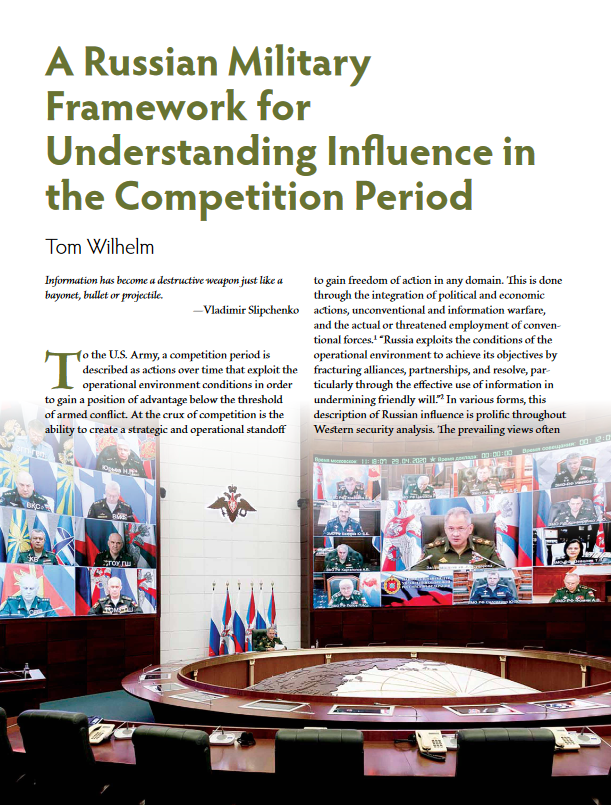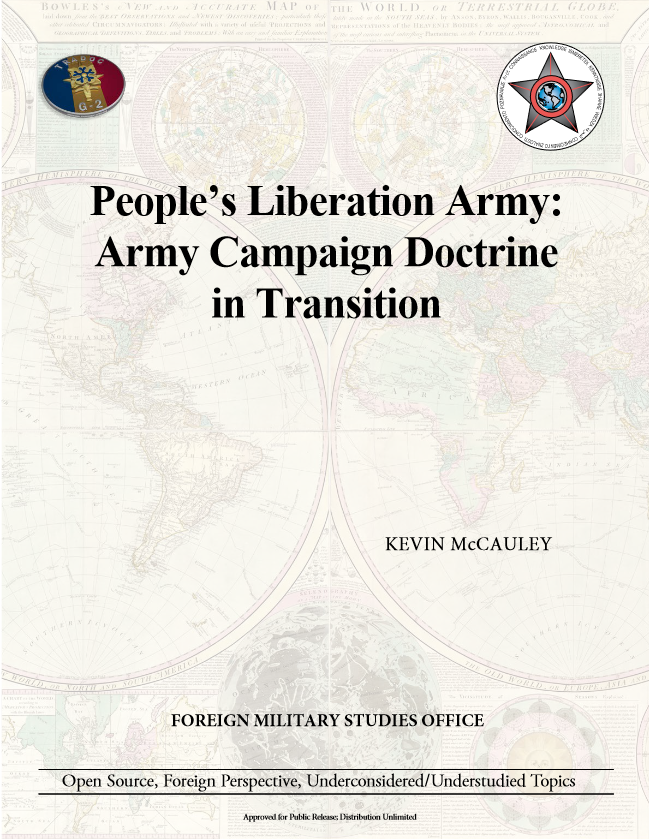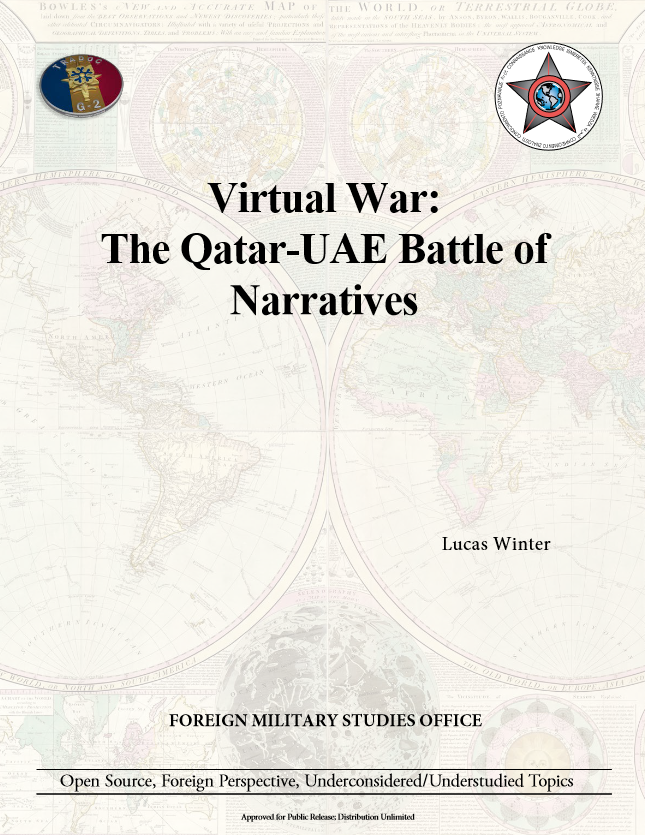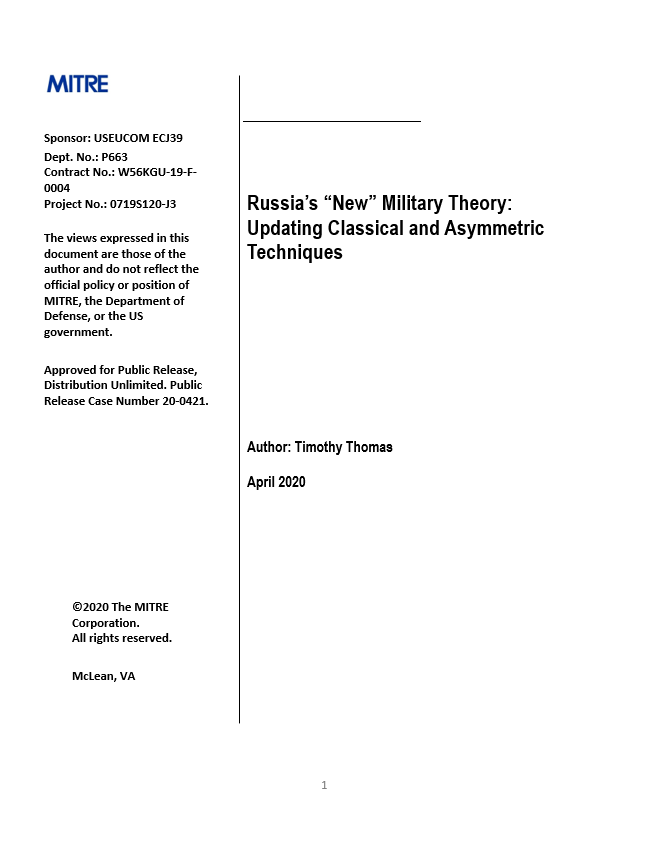Key Takeaways:
- Indonesia’s creation in 2003 of an elite counterterrorism unit, Detachment 88 (Densus 88), which received financial and training support from the United States and Australia, was a key factor in neutralizing Jemaah Islamiya (JI) and its offshoots.
- The dual-track approach of combining Densus 88 counterterrorism operations with the National Counterterrorism Agency’s (BNPT) deradicalization program, which reformed several high-level terrorists, has proven remarkably successful.
- Threats from terrorism, including the Islamic State (IS) and al-Qaeda (AQ)–affiliated groups, have not been eliminated in Indonesia. However, terrorism is at its lowest levels since before Densus 88’s founding and JI modules are increasingly dismantling themselves and accepting the legitimacy of the state. U.S. partners could learn from aspects of Indonesia’s experience in countering their own terrorism threats.
Armenia Struggles To Break Out of Russia’s Orbit (Matthew Stein) (February 2025)
Key Takeaways:
- Armenia believes that Russia and the Russian-led Collective Security Treaty Organization (CSTO) have failed to fulfill their obligations to Armenia during clashes between Armenia and Azerbaijan since the end of the Second Nagorno-Karabakh War in 2020.
- Armenia’s decision to leave the CSTO in 2024, limit security cooperation with Russia, and increase security cooperation with Western partners in the past couple of years point to an Armenian pivot away from Russia.
- While Western partners could be eager to capitalize on Armenia’s pivot away from Russia, an examination of Armenia-Russia bilateral security cooperation and Armenia-Russia economic ties will explain just how difficult it will be for Armenia to disentangle itself from Russia, despite its strong desire to do so.
Key Takeaways:
- Since launching its February 2022 “special military operation” in Ukraine, Russia has carried out a concerted effort to sway public opinion in its favor through information operations (IO) both in the post-Soviet space and globally, yet it has found unique success in countries in the Global South.
- While Russia has found a convincing narrative in the Global South, where its discourse taps into issues related to social identity, culture, and anti-colonial sentiment, in Central Asia and the Caucasus, where its discourse focuses primarily on unity, solidarity, and security, younger populations in particular have rejected its IO efforts, due to lingering resentment over Soviet colonialism.
- This brief suggests that the U.S. and its Allies have new opportunities to engage these post-Soviet populations, while recognizing the new challenges that they face due to Russia’s successful IO campaigns in the Global South.
Wrestling with Complexity: How the PLA Assesses Combat Capability (Kevin McCauley) (December 2024)
Key Takeaways:
- New quality combat capabilities [新质战斗力], which Xi Jinping prioritized for development in 2022, feature in many recent People’s Liberation Army (PLA) articles. Changes in warfare, technologies, and production are creating new combat capabilities. This creates the need to develop new combat capability assessment methods based on informationized and intelligent technologies, analysis of new-type operational forces, the expansion of operational domains, and the interaction of civilian production and military technological requirements. While the PLA is searching for improved methods to analyze the complexity of future operations, it appears to fail to factor in important data that could improve the accuracy of current capability assessments.
- The PLA appears to use many different assessment methods with no standard method and no uniformity of factors used to assess capabilities. Combat capability assessments are important to the PLA for supporting planning, command decisions, conducting operations, modernization, force development, and training, and the evaluation factors and missions included in capability assessments provide insight into planning, operations, and the factors the PLA considers important for successful future operations. Yet some assessments exclude important areas such as training, operational methods, officers’ professional military education level, and environmental factors. The PLA’s lack of a uniform method for assessing combat capability could lead to uneven and inaccurate assessments supporting decision-making for operations. The variation in assessment factors employed in assessments would also appear to lead to variations in accuracy between the evaluations.
- Future warfare and technological developments are creating a more complex and dynamic battlefield. This is driving PLA researchers to examine more accurate and complex methods for evaluating combat capability. The PLA increasingly seeks data-driven and qualitative features that require accurate assessment methods compared to more traditional subjective and
quantitative methods.
Gaza War’s Impact On The Middle East Strategic Landscape (Lucas Winter) (June 2024)
Key Takeaways:
- Three de facto strategic coalitions dominate the contemporary Middle East geopolitical landscape: the Iranian-led “Axis of Resistance,” the Turkish-led “Political Islam Coalition,” and the U.S.-led “Arab Normalization” Coalition, anchored by Egypt and Saudi Arabia. Hamas fits uneasily between the Axis of Resistance and Political Islam Coalitions, receiving tepid support from both but fully trusted by neither. The Arab Normalization Coalition does not support Hamas.
- Members of the three de facto strategic coalitions responded differently to Hamas’ 7 October attacks and their aftermath: “Axis of Resistance” members contributed calculated, largely symbolic military support; the Political Islam Coalition supported Hamas in media and diplomacy; and the Arab Normalization Coalition sought to maintain a neutral distance from the war in Gaza.
- Prior to 7 October, the Middle East was in the midst of a new era of regional détente, in which members of the different de facto strategic coalitions were re-engaging and de-escalating their conflicts. The War in Gaza shifted the regional strategic calculus in ways that are not yet clear. Three scenarios are presented for how these changes may occur, and how China and Russia may seek to benefit from them. The first scenario involves increased Turkish-Iranian policy convergence, the second a deepening of Turkish-Egyptian relations, and the third a “grand bargain” that includes Saudi Arabia, Iran and Turkey. Russia is more likely to benefit from the first two scenarios, while China is likely to benefit most from the third.
Beyond Borno: Islamic State’s Expansion Into Southern Nigeria (Jacob Zenn) (February 2024)
Key Takeaways:
- Although the Islamic State in West Africa Province (ISWAP) has historically been deeply rooted in northeastern Nigeria, recent patterns demonstrate that it is expanding operations to the more economically prosperous and majority Christian south.
- The most plausible explanations for ISWAP’s move south are to “outbid” the rival Sunni Muslim Group for Preaching and Jihad (JASDJ); to follow Islamic State (IS) “core” directives to attract attention by attacking Christians and other high-profile targets; and to divert the Nigerian army’s attention from the north and relieve counterterrorism pressure near ISWAP’s main bases.
- Beyond these heightened risks, ISWAP’s southern expansion threatens U.S. interests in Nigeria, Nigeria’s national security, and West African security more broadly
Key Takeaways:
- China and Tajikistan share a 477km border and have an estimated $1.78 billion in bilateral trade, which is significantly imbalanced in favor of China.
- Recent years have seen a significant improvement in relations between China and Tajikistan, with China constructing a military base in 2016 near Tajikistan’s border with Afghanistan and a November 2022 bilateral agreement to increase security cooperation.
- China’s security cooperation with Tajikistan does not appear to conflict or cause friction with Tajikistan’s main security cooperation partner, Russia, but nevertheless advances Chinese interests in the region at a time when Russian support is limited due to its invasion of Ukraine.
The People’s Liberation Army’s Evolving Close Air Support Capability (Kevin McCauley) (January 2024)
Key Takeaways:
- The ability of China’s People’s Liberation Army (PLA) to carry out close air firepower support missions has improved over the past decades.The PLA has considered aviation support to ground forces as another form of fire support. Command and coordination have changed over time although details of the process are not entirely clear. While the PLA defines close air support against ground and maritime targets, there is a notable focus on support to ground units.
- PLA Air Force (PLAAF) fire support is likely meant to be employed against deeper tactical targets,although the proximity of strikes is dependent on the precision of the munition employed.Army Aviation is likely intended to strike targets closer to friendly troops. Unmanned combat aerial vehicles (UCAV) will be used to a greater degree in the future, integrating intelligent technologies to coordinate swarm attacks against multiple targets or in sustained attacks against a single target.
- The PLA’s command and coordination structure for close air firepower support appears both more streamlined and simpler compared to U.S. close air support.It also does not appear as integrated with ground maneuver. The PLA is capable of air-to-ground precision strikes directly supporting ground force’s tactical combat but likely faces challenges in fully integrating these capabilities into a complex maneuver operation.
- PLAAF modernization is fielding increasingly advanced reconnaissance and targeting systems.The PLA’s emphasis on precision munitions improves the capability to strike targets closer to friendly troops and closely integrate fires with maneuver. Improved close air firepower support would significantly enhance ground combat and maneuver warfare. Improvements to China’s domestic chip-building capability and the development of a capable and redundant Beidou global navigation satellite system (GNSS) likely will support this effort.
- Recent research sponsored by China increasingly is influenced by U.S. close air support(CAS) theory and practice.PLA-affiliated scholars are closely studying the U. S. CAS process,communications, coordination, and weapons systems. While it is unlikely the PLA will copy U.S.procedures and organizations completely, it will likely adopt features it believes will improve its aerial fire support capabilities.
Key Takeaways:
- This study describes how Russian military theorists think about the initial period of war (IPW) concept and its relation to strategic operations, and posits that due to the nature of the special military operation, the IPW concept was likely in no way a part of the operational planning process.While there were likely political motivations for the use of the term “special military operation”instead of “war,” the term “war” was not used for the 2022 invasion of Ukraine, because it was not envisioned to meet the criteria for “war” as understood by Russian military theorists;
- As of the drafting of this report in August 2022, it is obvious that the nature of the conflict and Moscow’s plan for concluding it have changed. This study finds that Moscow’s failure to successfully conclude the special military operation as initially envisioned has caused Russia’s 2022invasion of Ukraine to now be considered at least a “local war” as understood by Russian military theorists. The Kremlin’s insistence on the continued use of the term has almost certainly been promoted to conceal its failure as originally conceived — a single combined arms operation that achieves a deceive result. This said, however, the invasion came to be categorized in the weeks and months following the first day of the hostilities is unimportant in regard to IPW, and therefore the focus of this study. This study’s focus is on the relationship (or lack thereof) between the Russian concepts of war, IPW, and special military operation, which are explained in detail;
- The differences between the Russian definitions of the terms “war” and “special military operation”mean little to those in the West, who often consider the latter to be a euphemism for the former, but these terms have great significance for the Russians. Russia’s decision to approach its 2022 invasion of Ukraine as a special military operation instead of war would have many ramifications for the invasion’s planning and conduct. This decision was most likely taken at the highest political levels,and almost certainly altered the General Staff’s planning process. The results of which became painfully apparent for the Russians during the critical and formative early days of the invasion;
Key Takeaways:
- This study describes the historical evolution of the Russian concept of the initial period of war (IPW). The concept has evolved substantially since its inception, which can be traced back to at least the early 1900s, but it generally pertains to the decisive strategic operations that occur during the first few days of war, that set conditions for strategic success, and the activities that occur before the war (period of imminent threat or preparation period in Russian military parlance) that make these strategic operations possible;
- It is important to note that the evolution of the IPW is closely linked to technological developments associated with the changing character of war. As an example, upon reflection about the Soviet failures of IPW in World War II, Soviet scholars attributed these failures to Soviet expectations that preparations for IPW in World War II would be conducted in the same manner as World War I. IPW preparations for the latter involved belligerents covertly putting elements of the armed forces onto wartime status, preparations for mobilization and deployment of forces, some initial (relatively) minor border engagements intended to protect assembly areas to facilitate decisive operations by the main force;
- Due to the technological innovations of the interwar period, the capabilities of weapons and military equipment were greatly increased. In addition, increased industrialization and economic power permitted nations, such as Nazi Germany, to maintain their militaries in a high state of mobilization readiness. The net effect of these developments was to substantially change the IPW preparation activities for World War II. In the Soviet view, Nazi Germany’s developments in the interwar period permitted the rapid massing and deployment of forces, while simultaneously being able to destroy troop formations and critical infrastructure. This meant that while Nazi Germany was still mobilizing, it was able to immediately route the first echelon of Soviet forces,while hindering further Soviet mobilization and deployment, setting the conditions which they believed would result in victory;
- As military technology develops, so does the IPW concept. The study also traces how the Soviets thought about IPW during the Cold War, and how prominent Russian military theorists understand IPW in more recent conflicts. Perhaps the most important conflict of recent years,from an IPW perspective, is the 1991 Gulf War. This application of IPW by the coalition, used precision guided munitions and massive air and missile strikes to destroy Iraqi air defense and command and control systems, that set conditions for a successful ground campaign, and eventual coalition victory. From the perspective of Russian military theory, the 1991 Gulf War was the par excellence example of what success during the IPW could achieve;
- Thus, the senior officer leadership of Russia’s Armed Forces fully understand both the significance of the IPW both in terms of military theory and in reference to historical examples.Yet, this does not yield a unified approach toward its planning. There are no templates involved,little by way of discernible patterns, with the objectives, tactics and scheme employed in the IPW varying from conflict to conflict;
Key Takeaways:
- An analysis of the military political situation testifies that in the current stage of the developing threats arising from military conflicts, it is significant that, in the conduct of land battle, tanks still will play one of the major roles as the main strike force of the ground troops.
- The Russian ‘special military operation’ in Ukraine, as well as the large quantity of tanks in the armed forces of many other countries in the world, supports this conclusion.
Key Takeaways:
- There are apparently no spots on the planet that are so remote, so inhospitable, and so devoid of trans-port and infrastructure that man will not fight over the possession of them. Mountains, jungles, and deserts have all seen their share of combat. People have even fought in the Arctic and in proximity to the Antarctic — and not just the indigenous populations. The land areas approaching and within the Arctic and Antarctic Circles provide unique challenges to military operations. Terms to describe this combat have included northern warfare (a Western-centric term that excludes the areas near the Antarctic), arctic warfare (a term which excludes the Antarctic as well as those inhospitable areas south of the Arctic Circle), and cold weather combat (there are permanent ice and snow-covered areas, but much of this area is devoid of snow and cold during the summer thaw, and movement and combat during the thaw can be quite difficult and requires different techniques and equipment).
- Geographers refer to the sub-Arctic, Arctic, sub-Antarctic,and Antarctic belts. The sub-Arctic and sub-Antarctic belts do extend at places below 40 degrees northern and southern latitudes, however, so this is not particularly definitive. Higher latitude combat generally occurs above 55 degrees northern and southern latitudes, understanding that blizzards, ice storms, and snowstorms do occur frequently and regularly below 55 degrees northern and southern latitudes. Sub-arctic combat is not necessarily easier than arctic combat, it just has different challenges.
Key Takeaways:
- Turkey has emerged as a drone superpower on the world stage. In just the past few years, Turkey has become one of a select group of countries in the world that can produce, use and export armed drones extensively, trailing only the United States, Israel, and China.
- Turkey’s innovative use of its cost-effective Bayraktar TB-2 drone involves using drone squadrons effectively as a mobile air artillery, thereby achieving overmatch by emphasizing quantity over quality. This strategy has impacted geopolitical outcomes in several regional conflicts, and has provided a strategy for middle sized powers to emulate. Several such powers—including Ukraine, Poland, Azerbaijan—are buying these cost-effective systems from Turkey with a view to do so. Other midsize countries with limited defense budgets are likely to replicate this approach, changing the nature of local conflicts and even the calculations of larger observing nations.
- Drones and anti-aircraft technologies that merge ISR with strike capabilities will increasingly impact the trajectories of conflicts. The entry barriers to these technologies are falling, making it easier for geopolitical issues to turn to war.
The Evolutionary Russian View Of Peacekeeping As Part Of Modern Warfare (Matthew Stein) (March 2023)
Key Takeaways:
- Russia views peacekeeping operations as a part of warfare, specifically that they can be utilized to achieve strategic objectives beyond conflict resolution
- Russia’s past peacekeeping operations have shown how these involved ending the conflict as quickly as possible and enforcing terms of any cease-fire agreement, including taking action that favored one of the belligerents as long as Russia remains in the dominant position.
- Russia’s Nagorno-Karabakh peacekeeping operation ended a conflict and helped the Russian government maintain influence in the Commonwealth of Independent States with a Russian military detachment in place for the foreseeable future, which can help explain how conflicts involving Russia are likely to end.
Cultivating Joint Talent: PLA Education And Training Reforms (Kevin McCauley)(February 2023)
Key Takeaways:
- Cultivating joint command talent and promoting realistic and complex joint training at the campaign and tactical levels is critical to the successful implementation of integrated joint operations, transformation efforts, and enhancing the People’s Liberation Army’s [PLA] overall combat capabilities. The PLA is implementing a “Triad” military education program to address problems with joint talent and training.
- The implications for the PLA of successful implementation of joint talent cultivation and improving joint training are significant for reaching its goal of an advanced military. While the PLA’s transformation will likely be a lengthy process, the PLA can still present a lethal opponent with its precision long-range strike and information warfare capabilities.
- The PLA’s modernization effort faces the complex task of integrating mechanized warfare, informationized warfare, and intelligent warfare systems and operational methods into the force concurrently. Reported difficulties educating officers and staff for informationized warfare raise questions about the PLA’s ability to integrate fully intelligent warfare technologies and operational methods into the force.
People’s Liberation Army: Army Campaign Doctrine In Transition (Kevin McCauley) (January 2023)
Key Takeaways:
- The PLA develops generic offensive, defensive, and special conditions campaign models to support planning and training for operational scenarios it believes are relevant to potential conflicts. These generic campaigns provide planning factors, force organization, and operational methods for combat.
- The choice of campaigns reveals that Taiwan and Indian conflict scenarios are the key scenarios for which the PLA is planning and training.
- Some of the campaigns do not appear to represent operational situations the PLA is likely to face in the near to mid-term.
- PLA doctrinal change is evolutionary, and in the past slow. The available PLA sources on Army doctrine appear to show incremental change to date due to developing technologies such as artificial intelligence or research on operational methods exhibited in recent foreign conflicts such as the United States military operations in Iraq and Afghanistan.
Key Takeaways:
- The Islamic State Central is increasingly publicizing the achievements of its affiliated African provinces, leading to what the FMSO’s Foreign Perspectives Brief authors call “The Islamic State’s African Turn.”
- The authors detail six potential benefits that IS Central might gain with such an “African Turn,” as well as what downsides might also accompany such a turn.
- Overall, the authors assess that the Islamic State’s African Turn is likely more tied to temporary successes of African provinces than it is an attempt to change the Middle Eastern character of the group.
Key Takeaways:
- Synopsis: Turkey has emerged as a drone superpower on the world stage. In just the past few years, Turkey has become one of a select group of countries in the world that can produce, use and export armed drones extensively, trailing only the United States, Israel, and China.
- In addition, it has innovated new ways to use its cost-effective Bayraktar TB-2 to achieve overmatch by emphasizing quantity over quality across an array of battlefields. Turkey’s innovative use of drone squadrons as a surrogate for an air force in a conventional battle has provided a strategy for middle-sized powers to emulate, resulting in several such powers—including Ukraine, Poland, Azerbaijan—buying these cost-effective systems from Turkey with a view to do so.
- Other mid-size countries with limited defense budgets are likely to replicate this approach, changing the nature of local conflicts and even the calculations of larger observing nations. This paper examines Turkey’s innovative use of the Bayraktar TB-2 drone, as a case study of how a mid-size power can drive geopolitical outcomes around the globe through drones.
Key Takeaways:
- The 2020 Nagorno-Karabakh War stood out as a significant chapter in the history of the conflict in the region. Not only did Azerbaijan take control over a large amount of territory, the Russian government deployed peacekeepers as part of the cease-fire agreement between the governments of Armenia and Azerbaijan. This marked the first time a peacekeeping force became involved in the conflict over the region and stood as another example of how Russia utilized a peacekeeping operation as a response to a conflict in the Commonwealth of Independent States (CIS).
- The CIS is made up of states of the former Soviet Union and is an area where the Russian government has special relationships and a sphere of influence. While the United States has arguably pulled back from peacekeeping operations in recent years and, as a result, the U.S. military has deemphasized them, Russia views peacekeeping operations as a key part of modern warfare. Like other military operations, Russians consider that peacekeeping operations can be utilized to achieve strategic objectives beyond conflict resolution.
- This article examines how Russia views peacekeeping operations as a part of warfare, including in its military doctrine and based on past conflicts in the CIS. It also examines how this applies to the most recent conflict in Nagorno-Karabakh and in the peacekeeping operation as a response to civil unrest in Kazakhstan. Insights from this may also inform potential outcomes of the current war in Ukraine.
“Cultivating Joint Talent: PLA Education And Training Reforms” By Kevin McCauley (2021-10-12)
Key Takeaways:
- This paper examines the PLA’s reforms targeting the development of joint commanders and staff, and efforts to improve joint training. Qualified joint officers and a well-trained joint force are fundamental requirements to propel the PLA into the echelons of the world’s advanced militaries.
- The PLA’s military education reform effort is to improve the quality of personnel in general, but an important emphasis of the current military educational reforms is focused on joint commanders and staff.
- The PLA intends to instill a general level of joint knowledge throughout the entire military as it pushes joint operations capabilities down to the tactical level. While the detailed outline of these reforms is known, the full extent and quality of implemented reforms is difficult to gauge.
Key Takeaways:
- The 1983 Military Encyclopedic Dictionary of the Soviet Union stated that military doctrine “contains two closely interlinked and interdependent aspects—a socio-political aspect and a military-technical aspect.”1 The socio-political aspect contains the greatest stability while the military-technical aspect encompasses matters directly pertaining to military organizational development and technical equipment. It helps determine the forms and methods for conducting operations.2
- Likewise, the dictionary states that the character/nature of war is composed of socio- political and military-technical components (the 2007 Military Encyclopedic Dictionary, Moscow: Eksmo, did not define the term). The socio-political aspect includes economic and socio-political causes, conflicts which led to war’s occurrence, class thrusts and political aims of belligerents, and the degree to which these aims are in conformity with social progress. This character of the socio- political component may change during a war’s course. The military-technical component of war’s character includes conventional and nuclear military hardware, the forms and methods of the conduct of military operations, and the scope, scale, and duration of war.3 While dated, the definitions offer most of the basic elements of these concepts today. Even though the article that follows is about the nature of future conflict, it should be kept in mind that the analysis is also about how Russian military authors may be sizing up their next version of military doctrine.
“The Russian Army And Maneuver Defense” By Les Grau And Charles Bartles (May 2021)
Key Takeaways:
- In the practice and application of historical analysis, the Russian General Staff closely examines details of past conflicts – noting what they learned and even unlearned – to keep their military science and training forward-looking. Maneuver defense is one of those lessons. Russia’s strategic defense Russia and the Soviet Union fought successful major wars using strategic defense and withdrawal. Russia defeated Napoleon by initially conducting a strategic defense and multiple withdrawals, followed by decisive counterstrokes.
- Up to his invasion of Russia, Napoleon’s strategy proved superior to that of his enemies and his operations were primarily offensive. Napoleon was often successful in surrounding an enemy army or defeating it in one decisive battle and then occupying its capital city and taking charge of the country.
- Russia defeated Napoleon’s invasion by losing battles, yet maintaining and rebuilding its army throughout successive retreats. As the army retreated, the Russians set fire to their own crops and villages, leaving scorched earth behind. Napoleon seized Moscow, yet Russia still refused to surrender and soon flames consumed Moscow. Napoleon had reached his culminating point, and his supply lines stretched to breaking. Russia was fighting a strategy of “war of attrition,” whereas Napoleon was fighting a strategy of “destruction.”
Key Takeaways:
- Due primarily to geographic and threat variances, Russia’s military conducts geostrategic planning differently from the United States. Russia is faced with a set of threats, real and imagined, from several vectors across a huge expanse of territory with a rather small population, factors which the U.S. does not confront. This directly impacts the style of planning for the Russian military, as US and NATO planning models do not directly apply. Those seeking to understand Russia ignore these differences at their own peril.
- This paper examines numerous aspects of Russia’s planning concepts that indicate how the nation’s Defense Ministry has chosen to confront perceived Western and other territorial challenges. U.S. planning is contrasted against Russian planning in some areas.
- After analyzing the Russian model, the conclusion reached is that Russia’s geostrategic planning for the initial period of war is underway and, if conflict erupts, the nation will be better prepared to gain the initiative than it has been in the past. Historically Russia has been caught unprepared for future conflicts, and President Vladimir Putin and Chief of the General Staff of the Armed Forces Valery Gerasimov want to bypass that potential fate.
“Russia’s Conduct Of War: How And With What Assets” By Timothy Thomas (April 2021)
Key Takeaways:
- In 2019, during a presentation at the Russian Academy of Military Science, General Staff Chief Valery Gerasimov summarized his presentation on strategy with the following statement:
- The main thing for military science today is the cutting-edge, continuous, goal-oriented research to determine the possible nature of military conflicts, develop a system of forms and methods of operation of both a military and nonmilitary nature, and determine trends for the development of weapons and military equipment systems.
Key Takeaways:
- The following summary first offers several ways that Russian theorists have defined a robot, starting in 1991. Second, the analysis compares Russian and U.S. approaches to employing robotics (from a Russian perspective) as well as tasks and principles of their use. Third, some of the uses of robotics in Russia are detailed, focusing on descriptions in military periodicals—in urban environments, in conjunction with engineer support, in unmanned aerial vehicle (UAV) use, with artillery, and their use in Syria.
- Fourth, legal and organizational issues of contention are examined that affect robotic use worldwide and regarding Russia. Fifth, the numerous problem areas are covered that Russia has encountered in its development of robotic capabilities, followed by a few conclusions. There are two appendixes. Appendix One lists some robotic employment principles and Appendix Two offers some photos of robots under development in Russia along with their operating parameters (and several not shown in the photographs).
Key Takeaways:
- Russia has been investigating a host of strike and fire concepts for at least a few decades, with one of the first reconnaissance-strike discussions documented in 1984. The quotation above indicates that reconnaissance-strike is not the only strike means under consideration in Russia, and that the number has increased over the years. In terms of terminology and context, Russia’s strike and fire forms are different from those of other nations. The forms under discussion in Russia are radio-electronic-strikes (REU) and radio-electronic-fire strikes (REOU), information-strike and – fire operations (IUO for strike operations, no abbreviation offered for -fire operations), remotely controlled cyber operations (RCW, which appear to be part of information-strikes), navigation strikes, and reconnaissance-strike1 F2 and -fire complexes (RUK and ROK, respectively).
Key Takeaways:
- From 2010 to 2017 Russian Colonel (reserves) S. G. Chekinov and Lieutenant-General (retired) S. A. Bogdanov wrote 13 interesting articles in the journal Military Thought (nine of them are summarized below) that had a major impact on how Western analysts understood Russian military affairs and way of war. Though the authors have not written publicly since 2017, their impact continues to be felt as the West grapples with how to confront Russian activities across all domains. Asymmetric and indirect actions, the initial period of war, deterrence, military art, forecasting, strategy, new generation warfare, and other topics were discussed, ending with an article in 2017 discussing war in the 21st century. Numerous aspects of these themes remain under discussion in Russia.
“Compendium Of Central Asian Military And Security Activity V8” By Matthew Stein (2021-01-20)
Key Takeaways:
- Since Central Asian states gained independence in 1991, new regional military and security alliances have been created (some of which are Russian-led), new military partnerships with non-NATO countries have been established, a number of joint military exercises have been conducted, dozens of high-profile incidents of violence and civil unrest have taken place, and military installations have been used by foreign militaries. While this activity gained attention, it has not been collectively compiled. A compilation of this activity can serve as a guide for current and future military and security involvement in Central Asia.
- The first section of the compendium is organized alphabetically and includes entries on Central Asian military facilities and installations (bases, air fields, etc.), and military and security organizations past and present. The second section is also organized alphabetically and includes joint exercises of regional militaries and security forces (Note: the exercises are organized alphabetically by the title of exercise and then chronologically if the exercise was part of a series or conducted annually; the names of some exercises are transliterated from Russian, ex. Tsentr, Grom, Poisk, etc., and these are also listed alphabetically with names of the exercises in English; the untitled joint exercises are listed last and are organized chronologically). The third section is a list of Central Asian military and security structures and other (non-joint exercises) security cooperation activity organized by country. The fourth section is a list of major incidents of violence and civil unrest in Central Asia organized by country and then chronologically.
Key Takeaways:
- Although US security concerns have recently focused to a large degree on China, it is Russia that is the unpredictable wildcard. The country has stumbled in more ways than one during the past several months. In March 2020, it overplayed its hand in a game of oil supply-price brinksmanship with Saudi Arabia. The ruble is under inflation pressure. And the Kremlin’s initial fumbling of the coronavirus outbreak only added to its impact. In late May, Russian state press reported that Moscow could face a 7.5 percent drop in GDP following the pandemic.1 One of the most telling signs of pressure on the Kremlin was the decision—no doubt a reluctant one—to postpone the grand 75th anniversary events linked to VE-Day on 9 May and reschedule a more modest celebration for 24 June. During this tumultuous period, a Levada poll saw a slide in President Vladimir Putin’s popularity to 59 percent, a six-year low.
Key Takeaways:
- To the U.S. Army, a competition period is described as actions over time that exploit the operational environment conditions in order to gain a position of advantage below the threshold of armed conflict. At the crux of competition is the ability to create a strategic and operational standoff to gain freedom of action in any domain. This is done through the integration of political and economic actions, unconventional and information warfare, and the actual or threatened employment of conventional forces. “Russia exploits the conditions of the operational environment to achieve its objectives by fracturing alliances, partnerships, and resolve, particularly through the effective use of information in undermining friendly will.” In various forms, this description of Russian influence is prolific throughout Western security analysis. The prevailing views often include the notion that much of Russian influence over events is planned and orchestrated. This is certainly true in many instances; however, identifying the wiring of Russian influence can be difficult as it can not only come from planned operations but also from standard geopolitical practice, spontaneous civic activities, and many other actions and events that contribute to achieving Russian objectives.
“People’s Liberation Army: Army Campaign Doctrine In Transition” By Kevin McCauley (2020-09-01)
Key Takeaways:
- This monograph examines current People’s Liberation Army (PLA) Army campaign doctrine, with a discussion of PLA theorists’ vision of the evolutionary development of warfare to provide context for current doctrine as well as potential future direction. The PLA develops doctrinal joint and service campaign scenarios for possible offensive and defensive operations. PLA campaigns represent the operational level of war between strategic operations and tactical combat. The PLA’s current focus on specific campaigns provides insight into Beijing’s perception of potential conflict scenarios. The campaign scenarios provide commanders and staff data on command and control, coordination, combat actions, support, and other critical campaign elements for specific operational environments. The description of each campaign’s operational environment and combat actions provides valuable support to operational planning and a context for staff and unit training for their specific operational mission. The Army campaigns are executed as components of a joint campaign, or as a primarily independent Army campaign with support from other services.
“Virtual War: The Qatar-UAE Battle Of Narratives” By Lucas Winter (2020-05-28)
Key Takeaways:
- Over the past decade, strategic competition between Qatar and the UAE has evolved into low-level information warfare. What began as disagreements on foreign policy in the wake of the Arab Spring has escalated into a conflict to shape and control information flows in cyberspace. Although not always visible, Qatari-Emirati competition has become a persistent feature of the regional Operational Environment (OE). Their competition in the cyber-information sphere is part of a broader competition for influence involving Turkey, Qatar and their allies, on the one hand, and Saudi Arabia, Egypt, the UAE and their allies, on the other.1 One of Qatar’s main contributions to the Turkish-led axis is the employment of Arabic-language media outlets to influence local and foreign perceptions of the OE. The adversarial Qatar-UAE relationship has more recently morphed into a nascent cyber conflict to control not only the narrative but also digital data and information. Hoping to become hubs of the new digital economy, both countries are investing in cybersecurity and artificial intelligence (AI) technologies in ways that will enhance their capabilities to shaper perceptions of the OE.2 Their conflict will continue to be a dynamic factor shaping the regional OE, and its evolution highlights the changing character of information war.
Key Takeaways:
- A new understanding of warfare appears under development in Russia. Whether it is actually “new” is open for discussion, but ideas were advanced by Russia’s top leadership indicating that is the case. In June 2019 Russian Defense Minister Sergey Shoygu stated that modern conflict requires new approaches and that developing a new theory of warfare is the main task of the Armed Forces. Shoygu offered that “conflicts of a new generation involve a combination of classical and asymmetrical methods of conducting armed combat, where hostilities are fleeting, and there is simply no time for correcting mistakes.”[1] He added that new reconnaissance assets, along with weapons based on hypersonic and laser energy technologies, are impacting the forms and methods of troop operations.
- [1] No author or title provided, Interfax, 18 June 2019.
2020-03-26 Russian Influence In The Competition Period
Key Takeaways:
- U.S. Army Training and Doctrine Command explains that, in a state of continuous competition, Russia exploits the conditions of the Operational Environment to acheive its objectives without resorting to armed conflict by fracturing alliances, partnerships, and resolve (TP 525-3-1).
- This framework helps identify Russian influence in the competition period. It is developed from the Russian military perspective to enhance situational awareness and critical thinking for professional military education. It can be used in conjunction with other material, but does not replace nor update similar products on this topic.
“Russian Information And Propaganda Activities” By Timothy Thomas (2020-04-31)
Key Takeaways:
- Russia has long been captivated by the power of information as a weapon, most notably in a historical sense using propaganda to influence and persuade audiences. With the onset of the information age, the concept’s development and application increased dramatically. The power of information-technologies when applied to weaponry increased the latter’s capabilities due to increased reconnaissance and precision applications. The power of social media was used to influence populations both at home and abroad. Both developments fit perfectly into Russia’s information warfare concept, whose two aspects are information-technical and information-psychological capabilities. Information’s universality, covertness, variety of software and hardware forms and implementation, efficiency of use when choosing a time and place of employment, and, finally, cost effectiveness make it a formidable commodity when assessed as weaponry.
Click Here to access more Foreign Perspectives Briefs

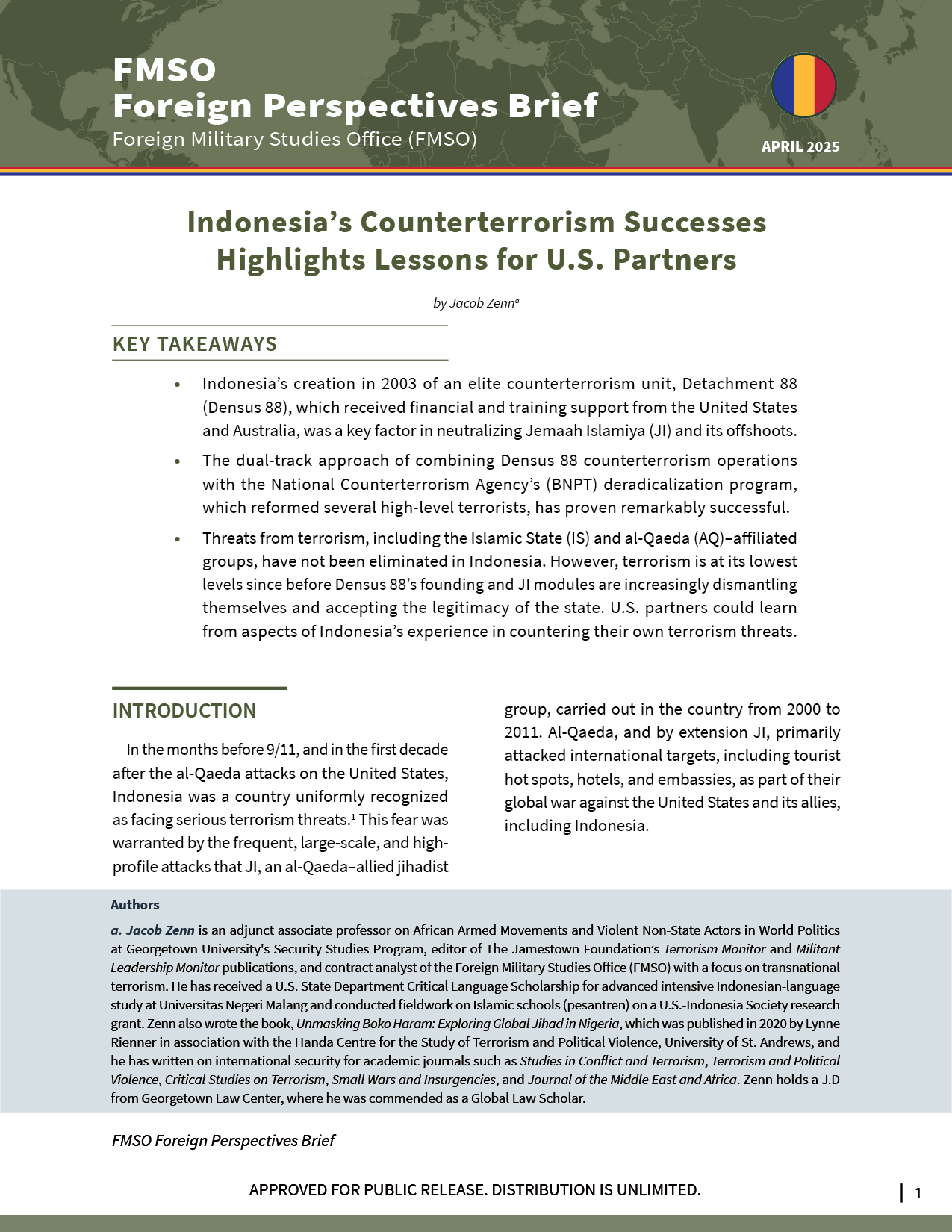
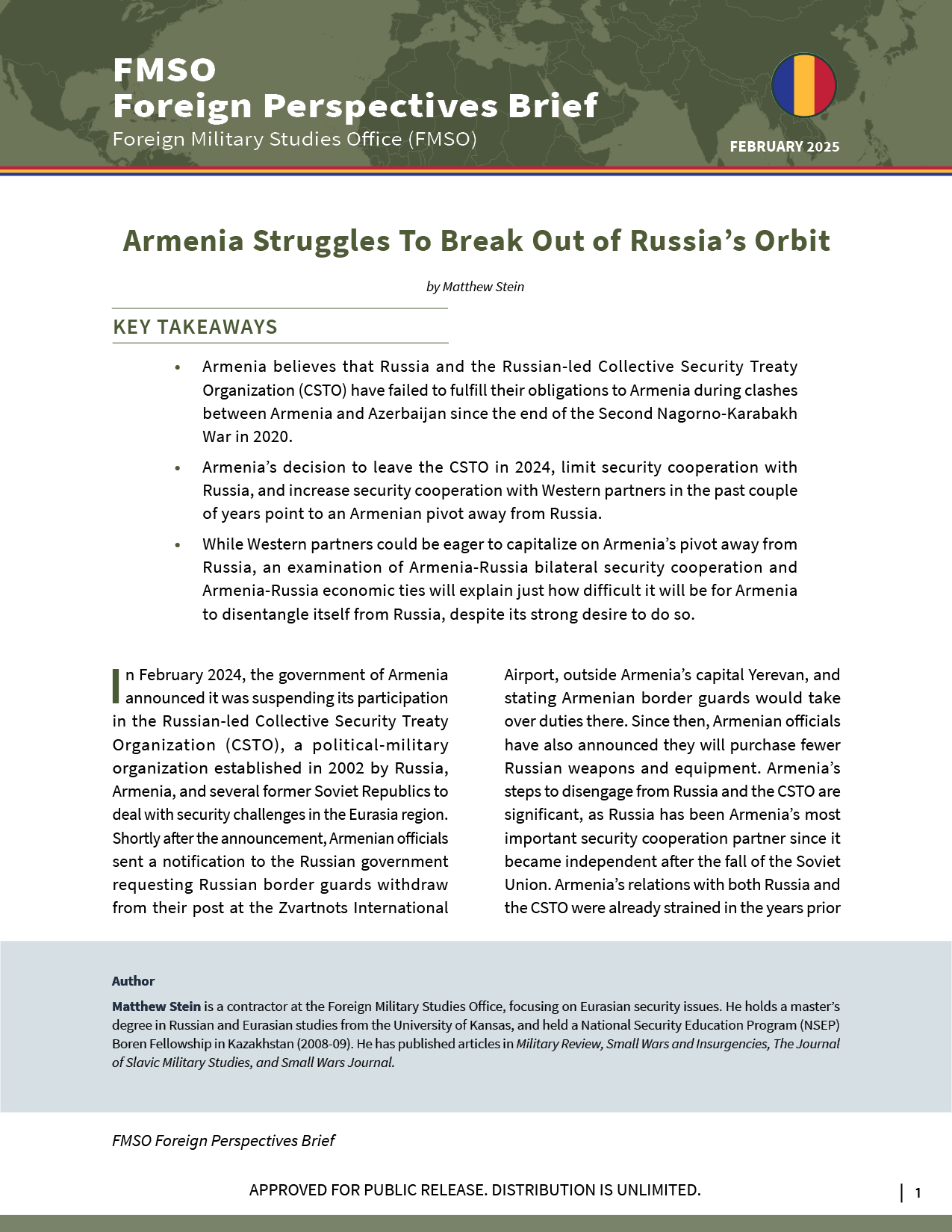
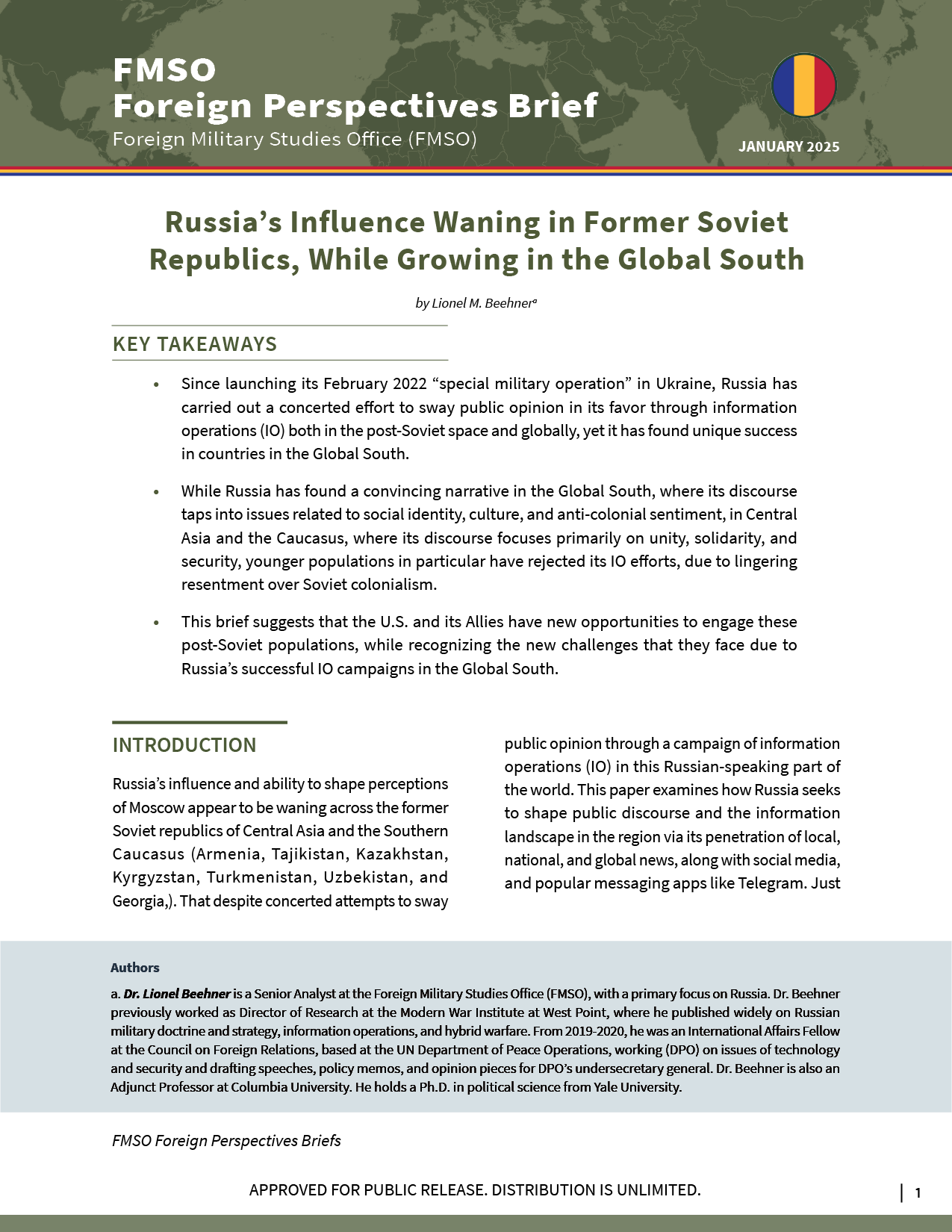
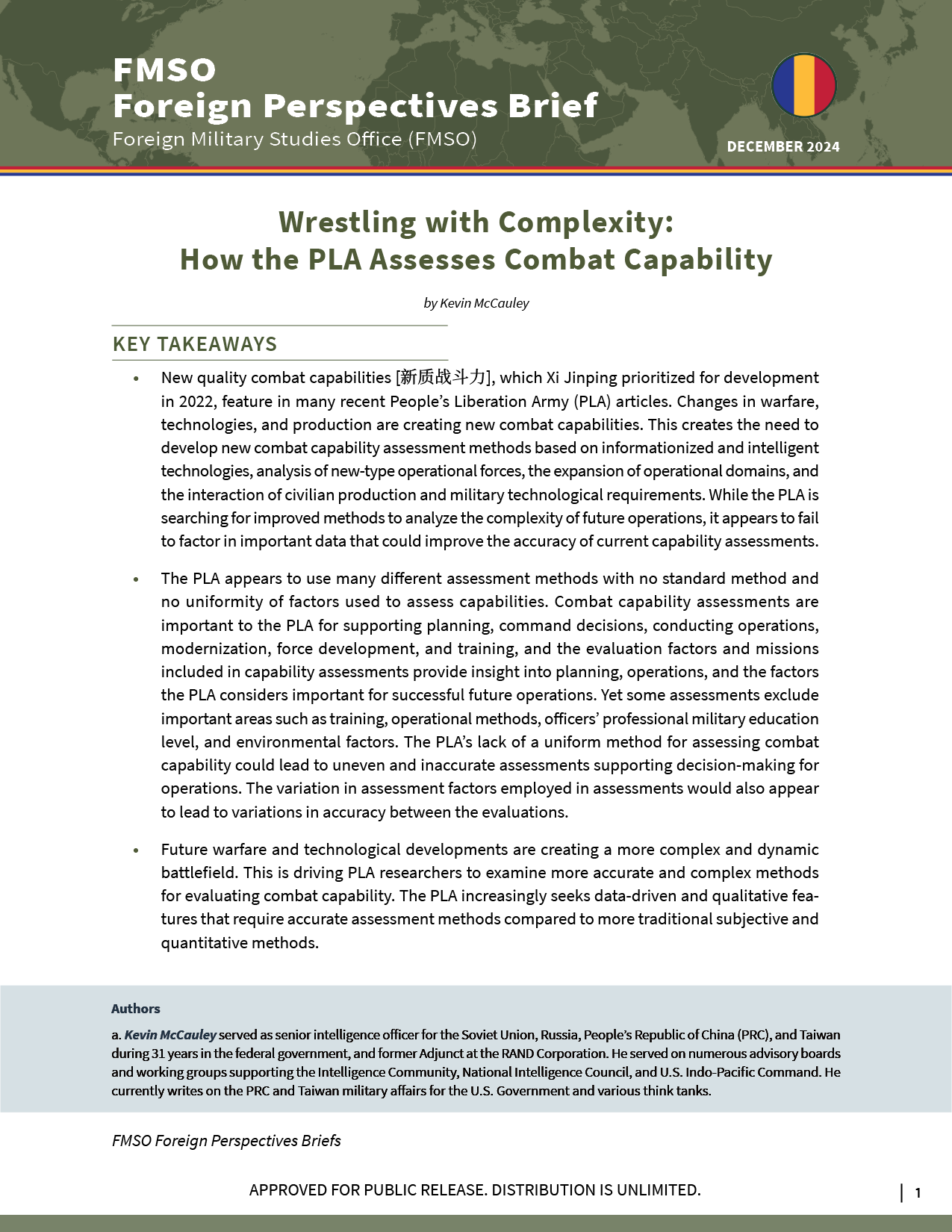

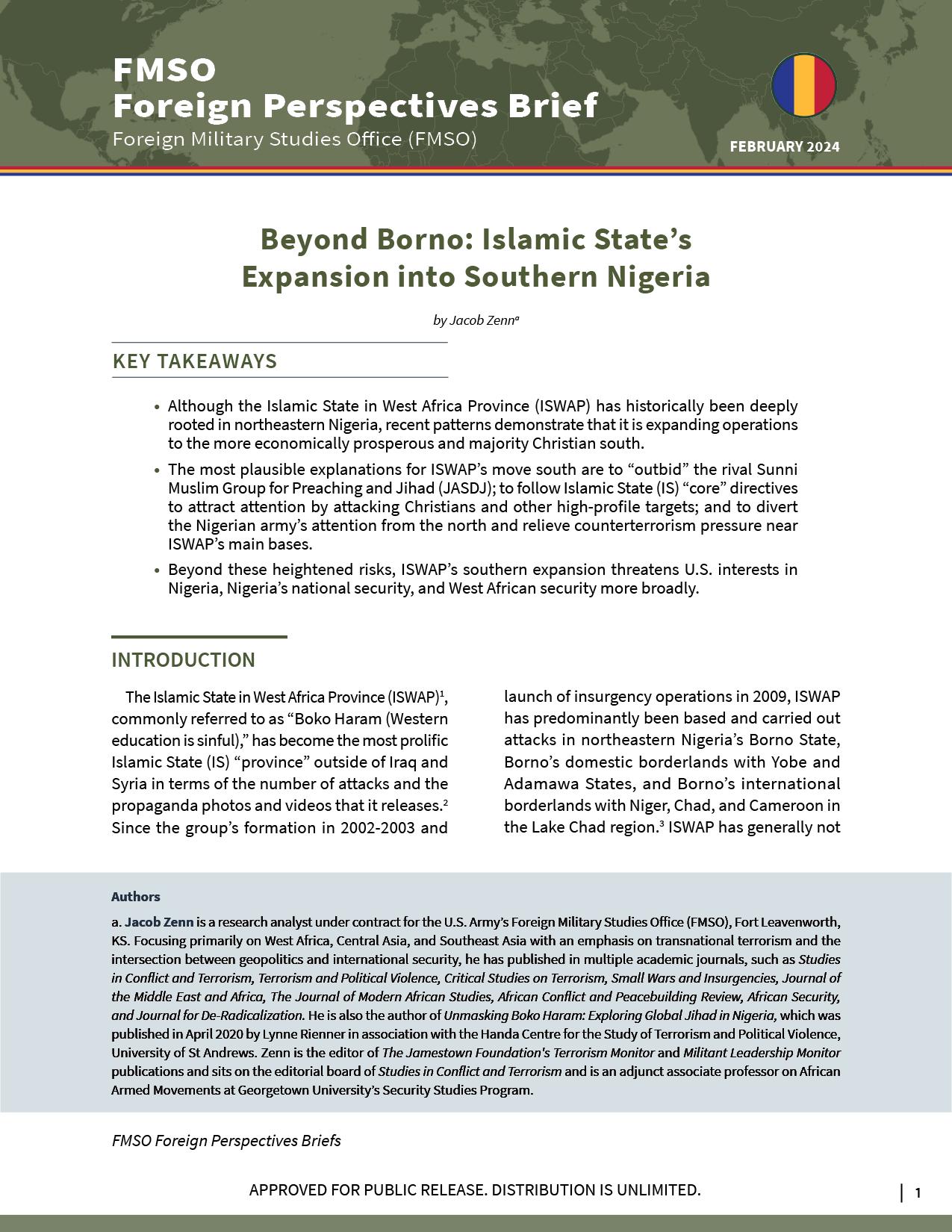
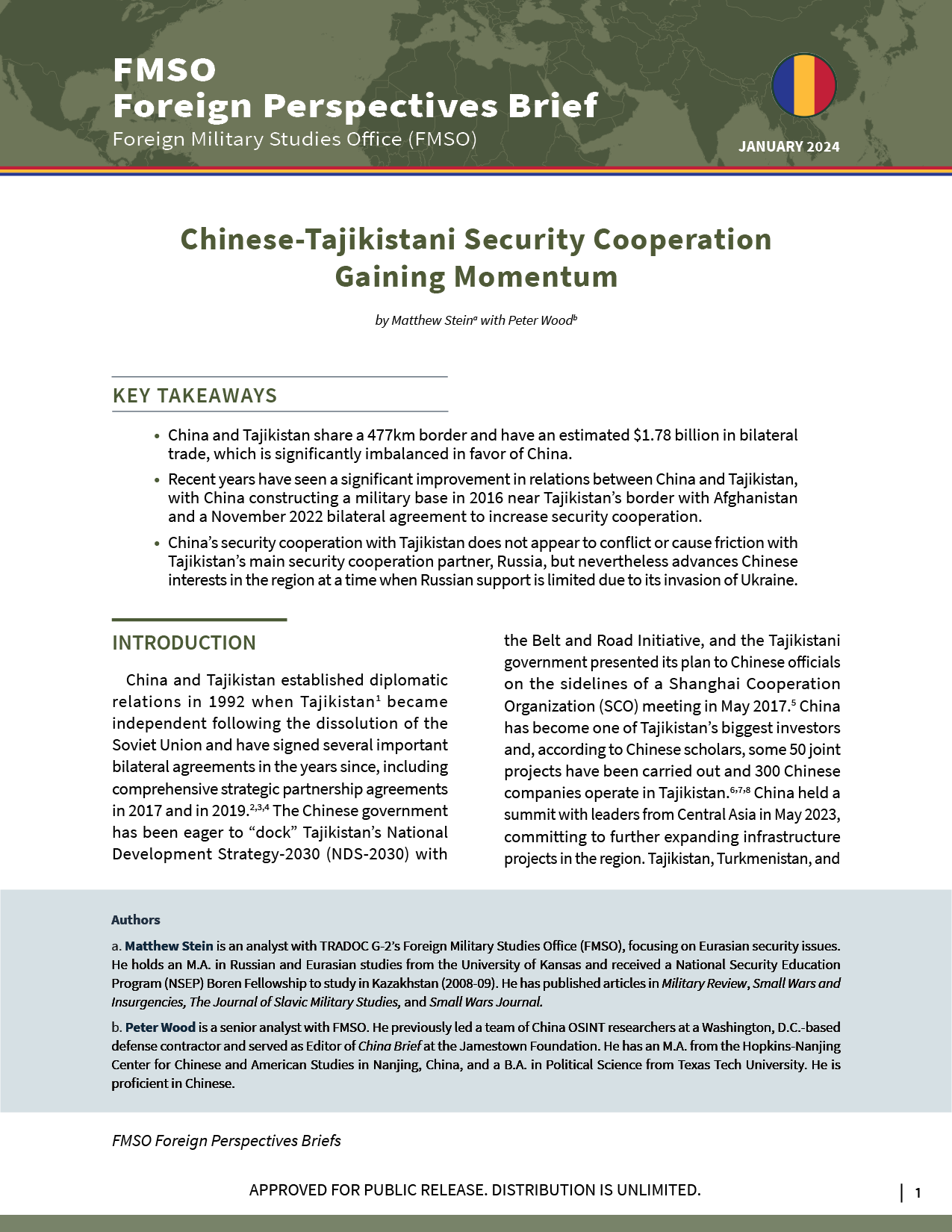
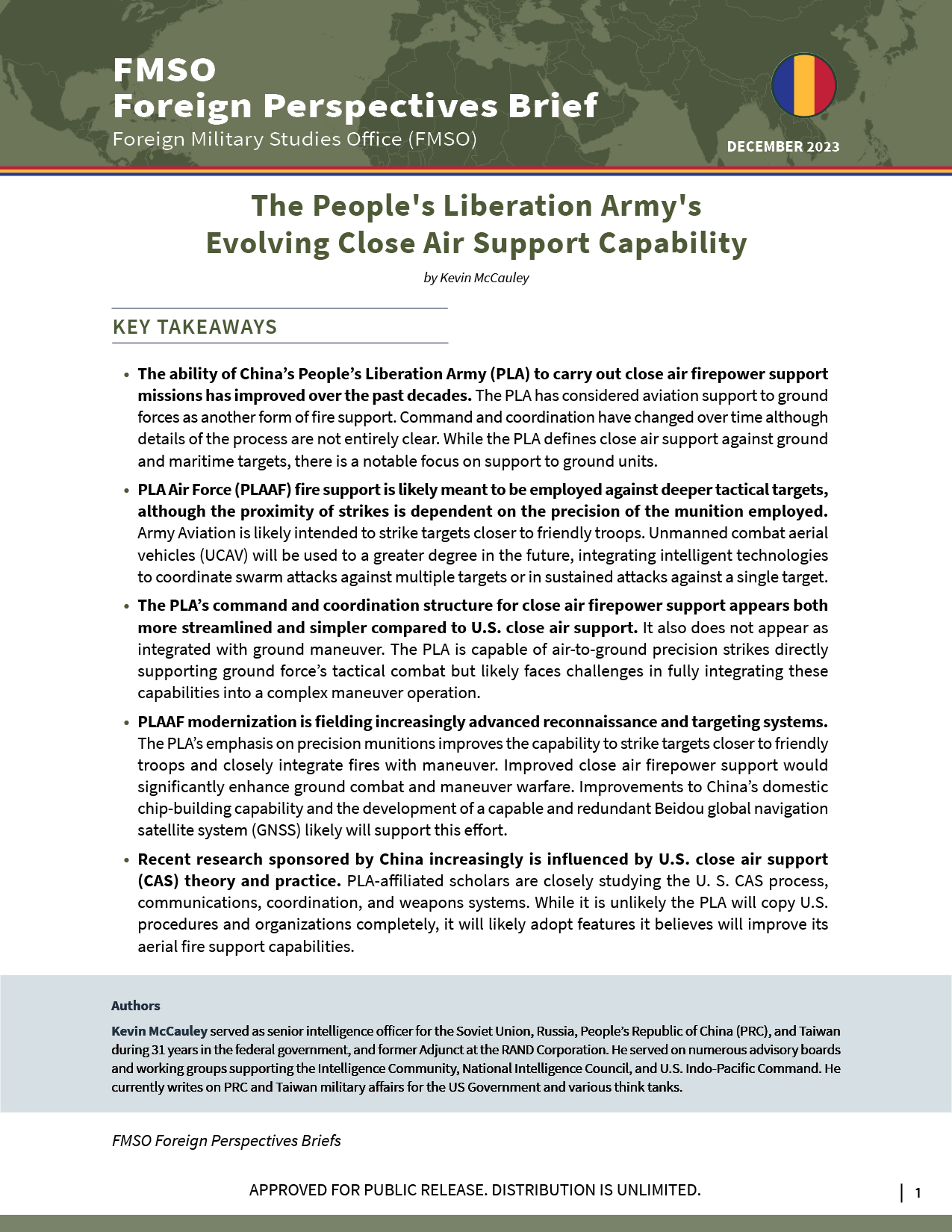
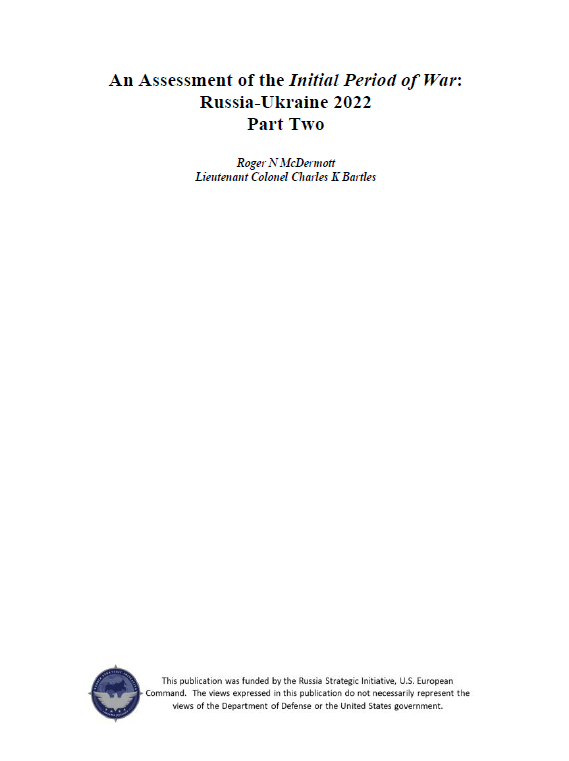
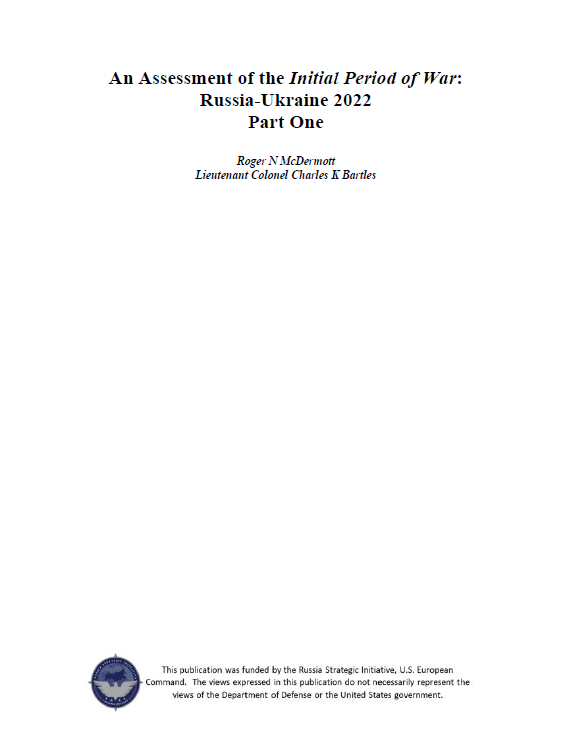


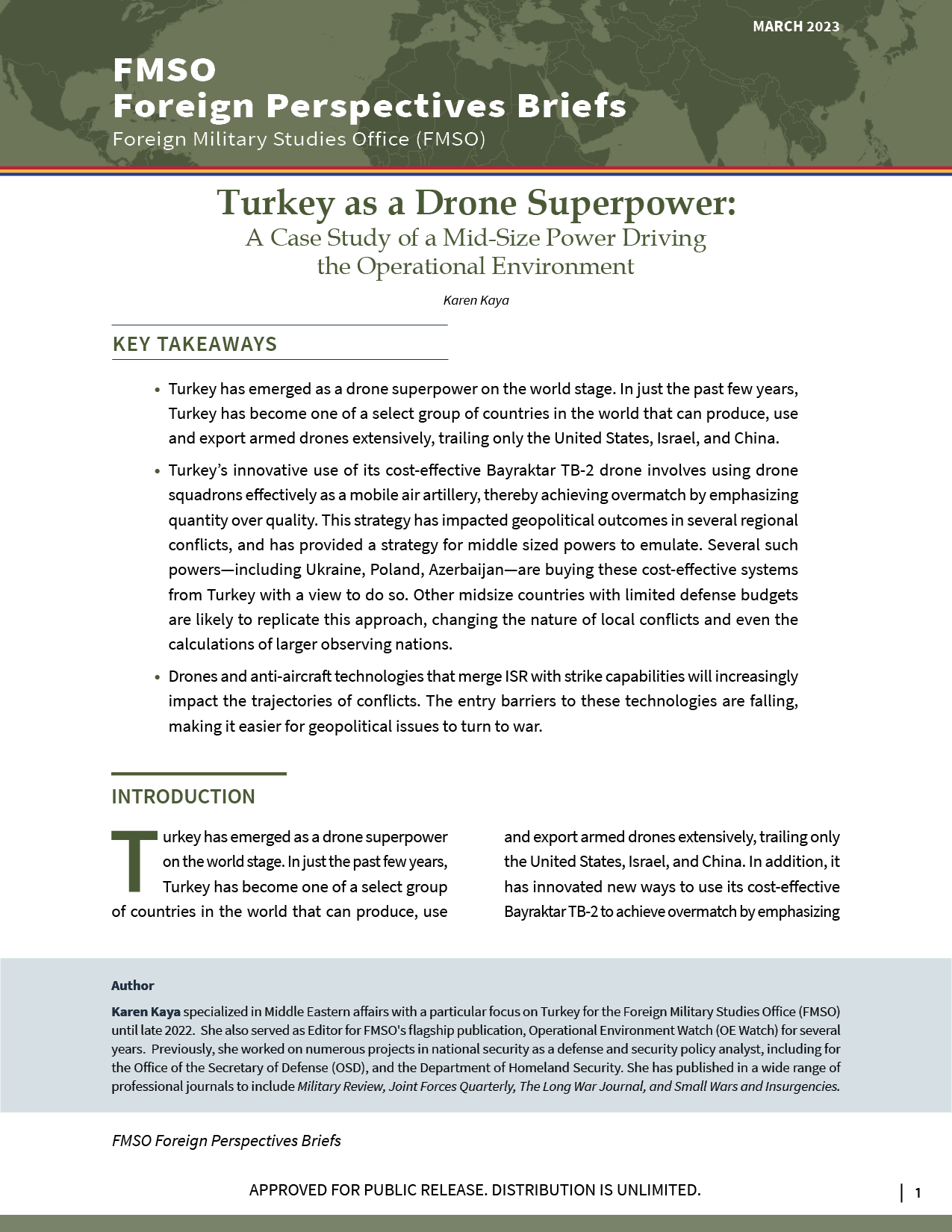
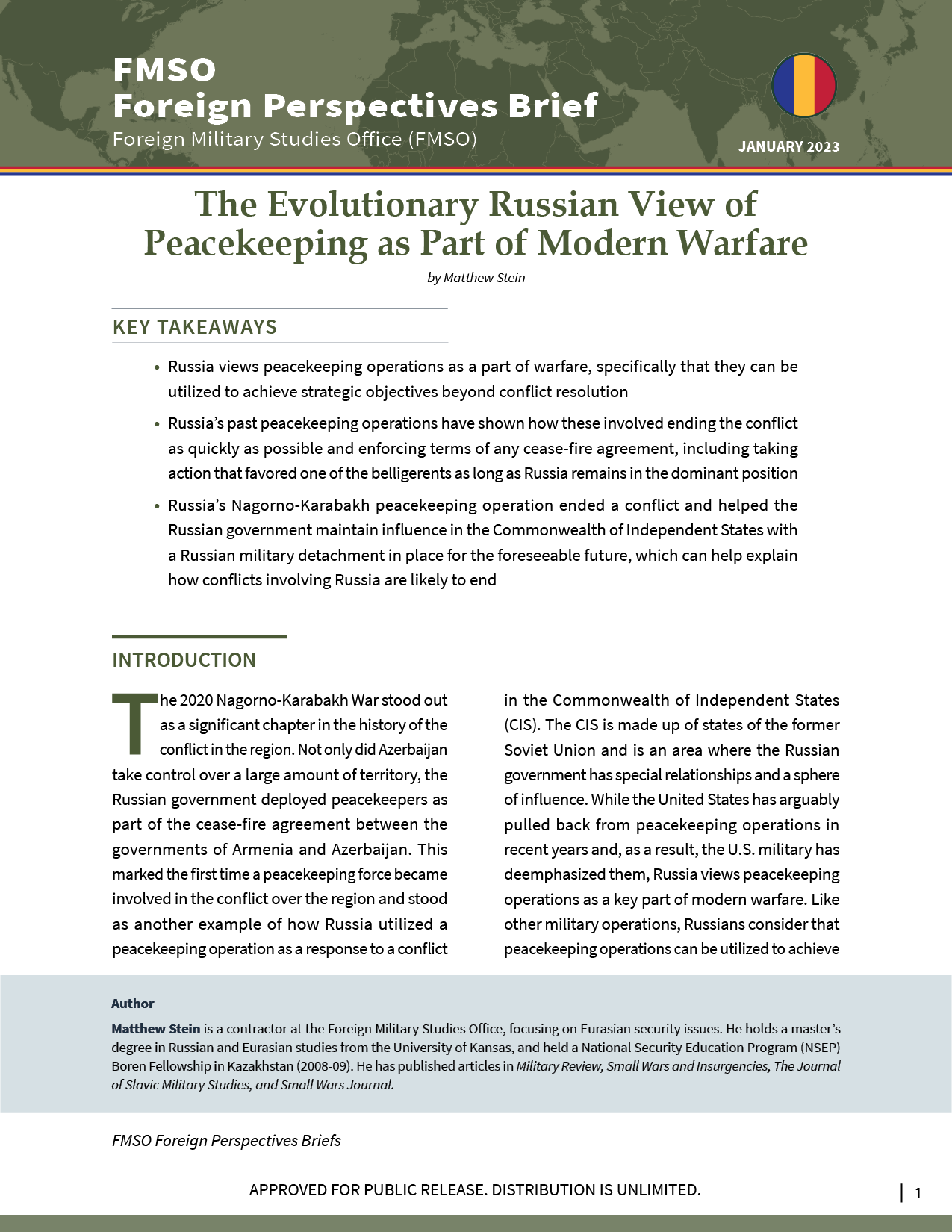
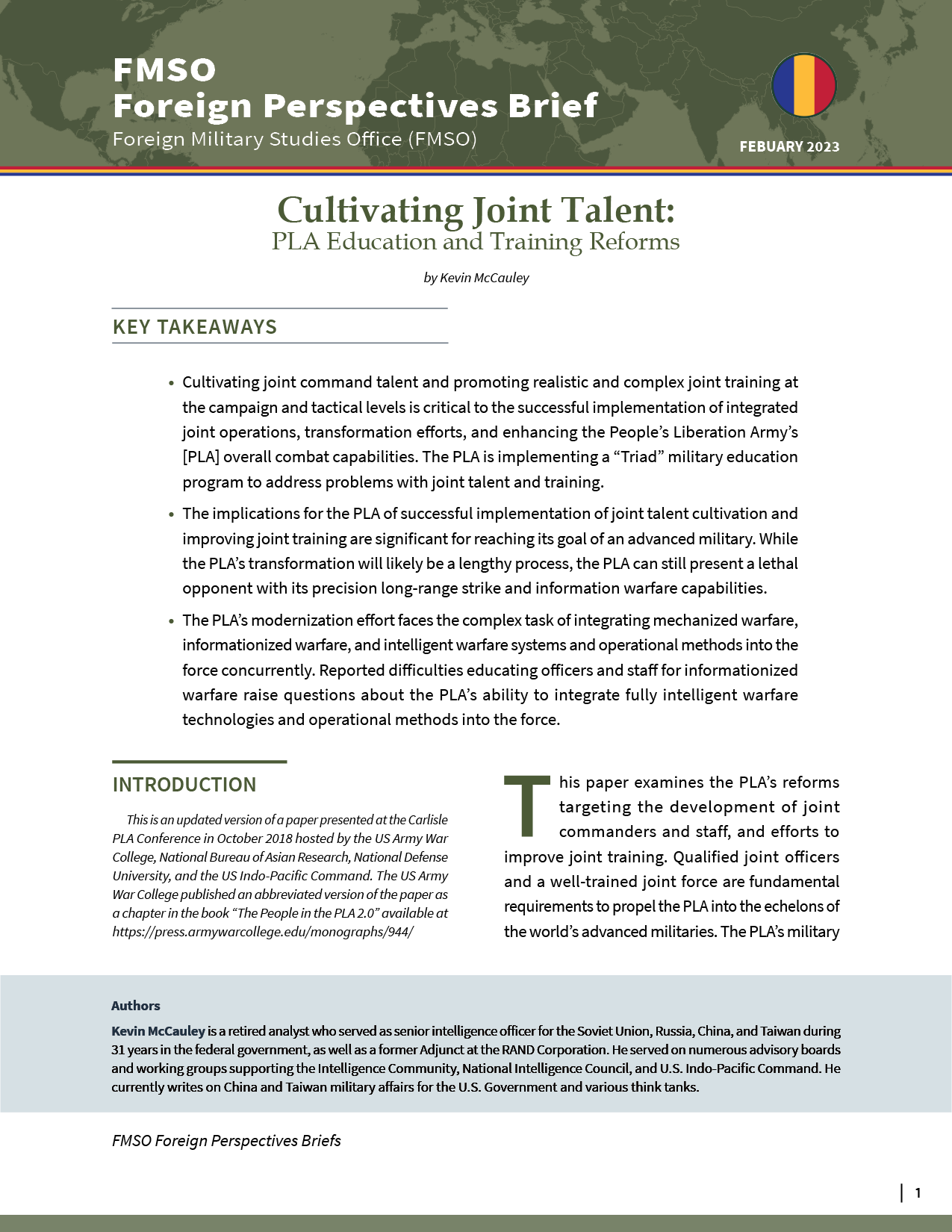
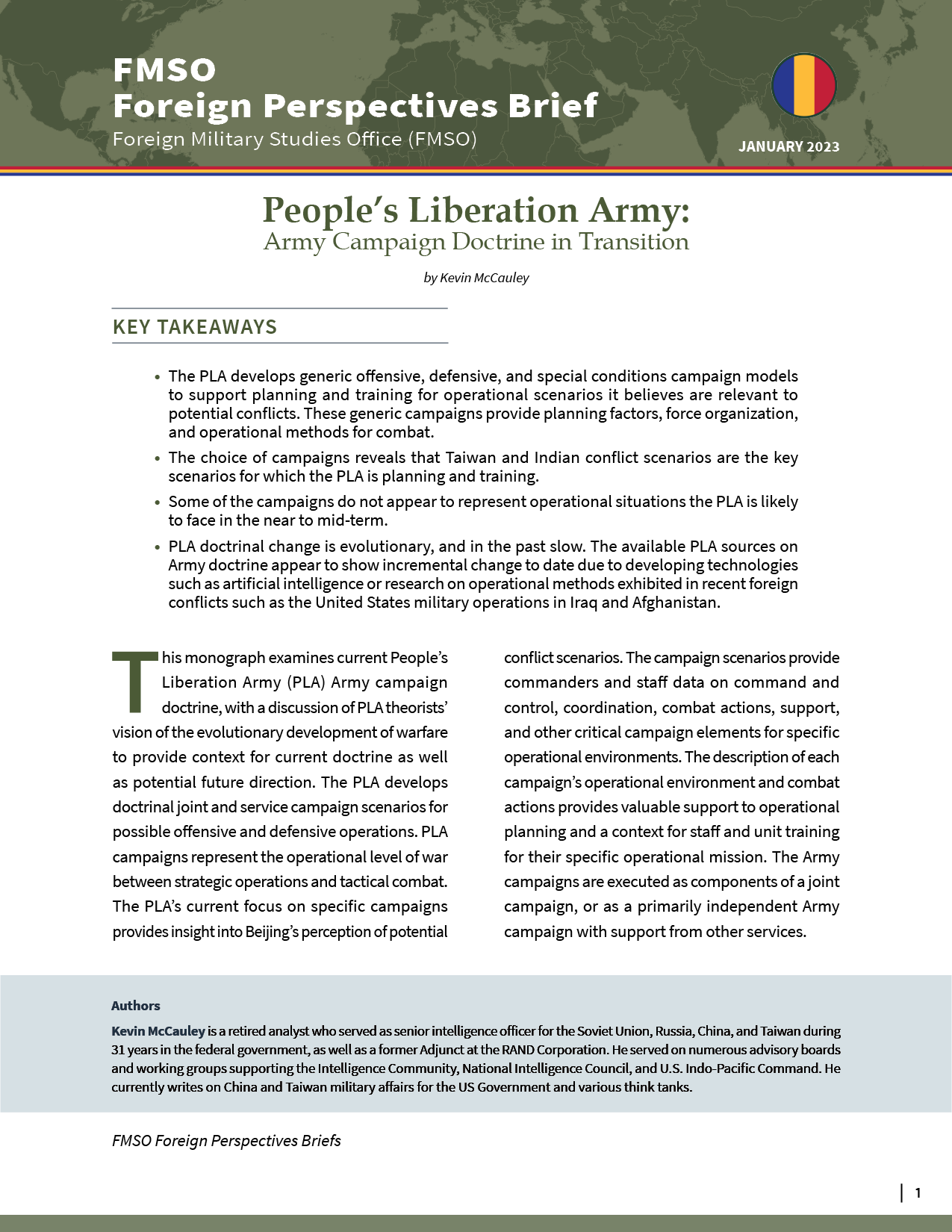


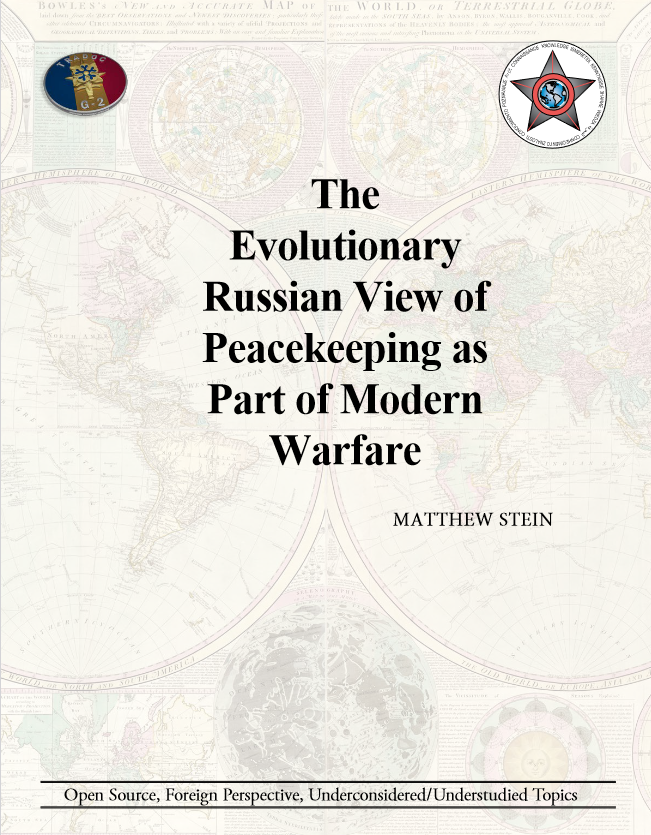
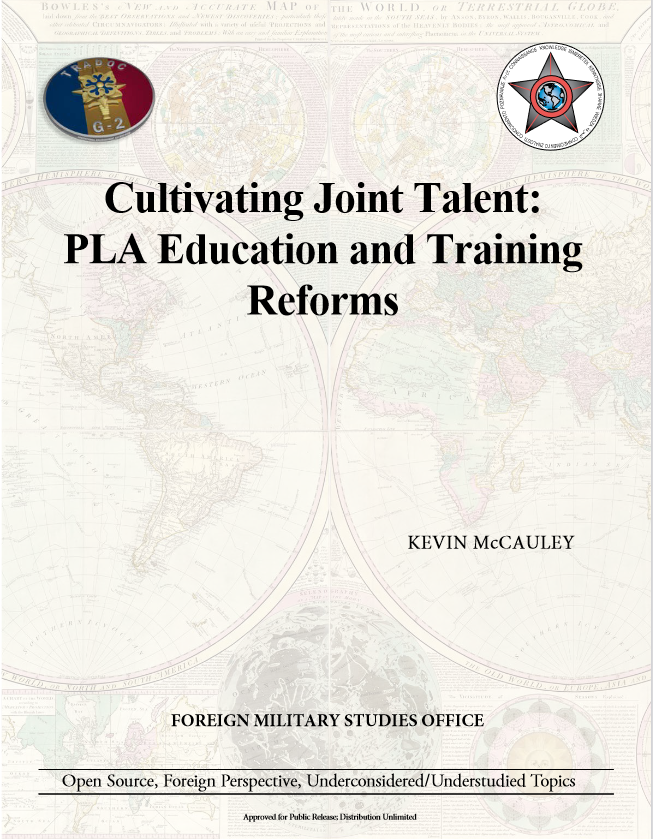
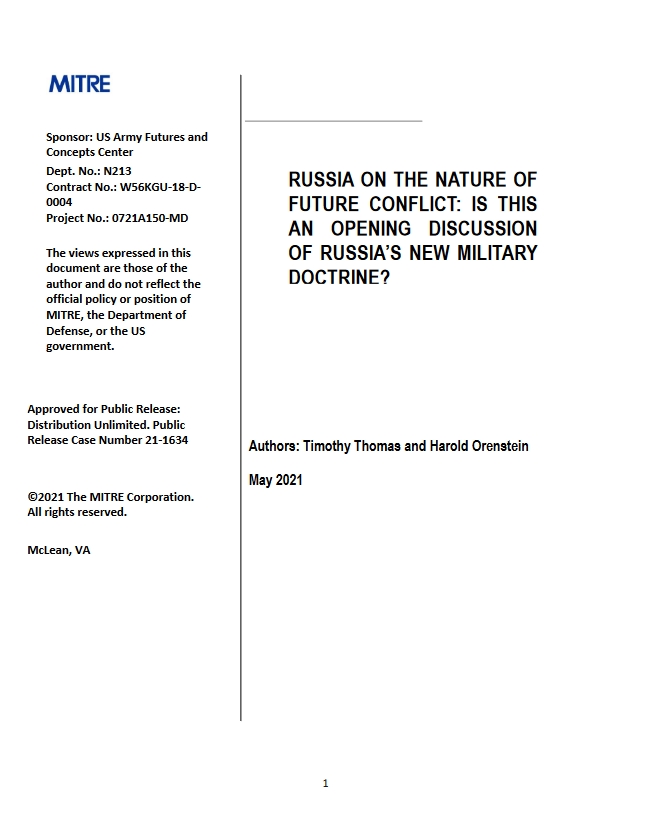
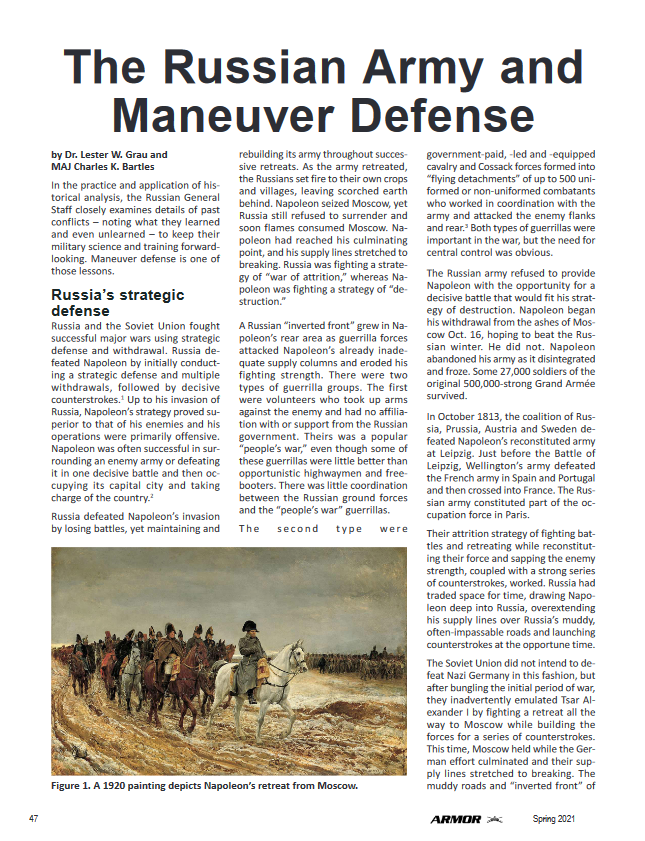


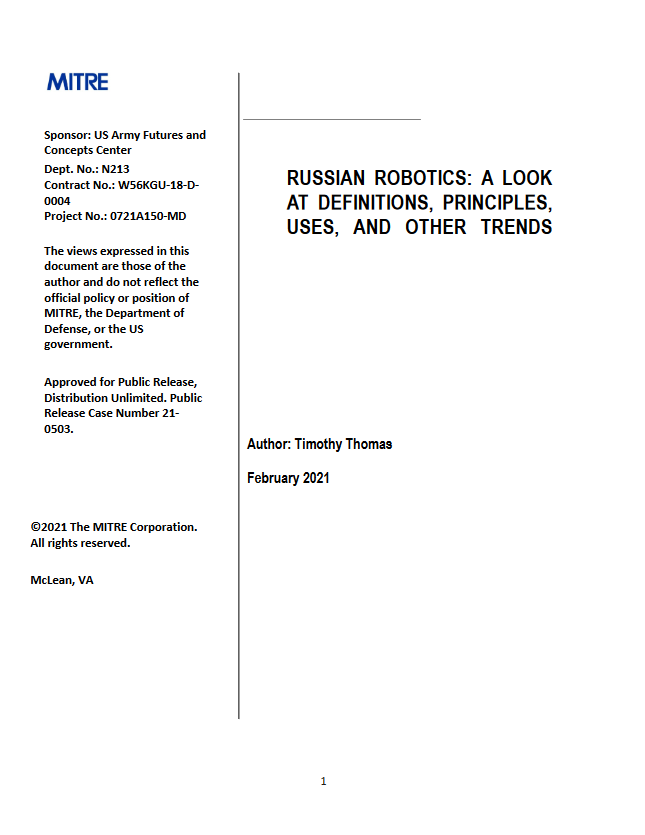

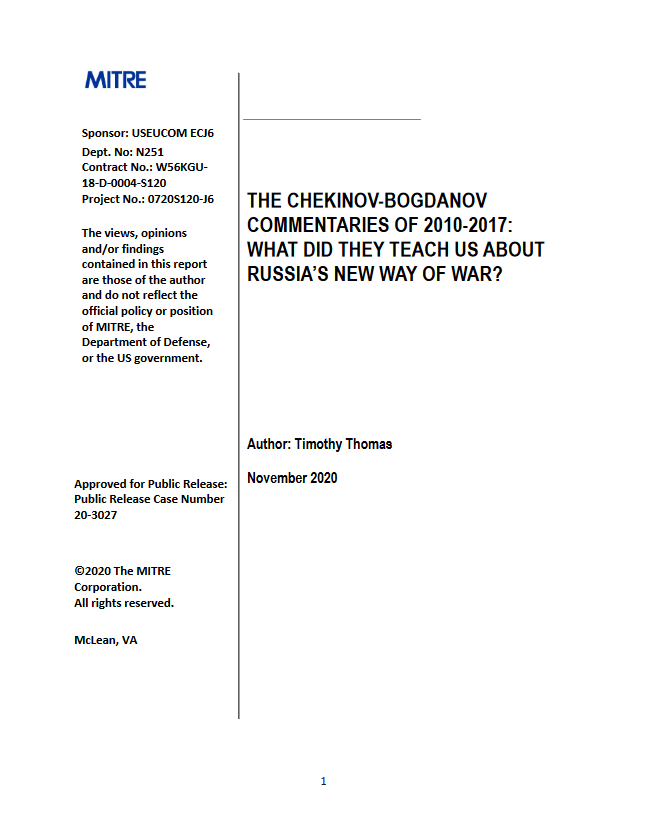

![2020-10-15 A Survey of Russia Security Topics for 2020 and Just Beyond [BG (Ret.) Peter B. Zwack]](https://fmso.tradoc.army.mil/wp-content/uploads/2023/05/2020-10-15-A-Survey-of-Russia-Security-Topics-for-2020-and-Just-Beyond-BG-Ret.-Peter-B.-Zwack.png)
